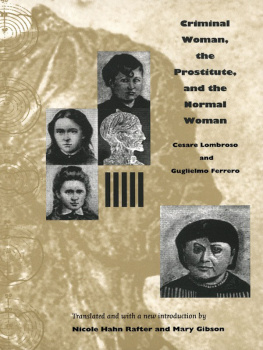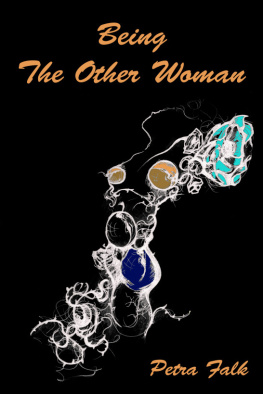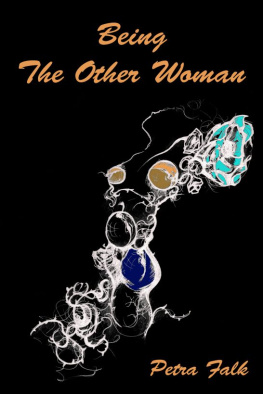Cesare Lombroso - Criminal Woman, the Prostitute, and the Normal Woman
Here you can read online Cesare Lombroso - Criminal Woman, the Prostitute, and the Normal Woman full text of the book (entire story) in english for free. Download pdf and epub, get meaning, cover and reviews about this ebook. year: 2004, publisher: Duke University Press, genre: Romance novel. Description of the work, (preface) as well as reviews are available. Best literature library LitArk.com created for fans of good reading and offers a wide selection of genres:
Romance novel
Science fiction
Adventure
Detective
Science
History
Home and family
Prose
Art
Politics
Computer
Non-fiction
Religion
Business
Children
Humor
Choose a favorite category and find really read worthwhile books. Enjoy immersion in the world of imagination, feel the emotions of the characters or learn something new for yourself, make an fascinating discovery.
- Book:Criminal Woman, the Prostitute, and the Normal Woman
- Author:
- Publisher:Duke University Press
- Genre:
- Year:2004
- Rating:5 / 5
- Favourites:Add to favourites
- Your mark:
- 100
- 1
- 2
- 3
- 4
- 5
Criminal Woman, the Prostitute, and the Normal Woman: summary, description and annotation
We offer to read an annotation, description, summary or preface (depends on what the author of the book "Criminal Woman, the Prostitute, and the Normal Woman" wrote himself). If you haven't found the necessary information about the book — write in the comments, we will try to find it.
Criminal Woman, the Prostitute, and the Normal Woman — read online for free the complete book (whole text) full work
Below is the text of the book, divided by pages. System saving the place of the last page read, allows you to conveniently read the book "Criminal Woman, the Prostitute, and the Normal Woman" online for free, without having to search again every time where you left off. Put a bookmark, and you can go to the page where you finished reading at any time.
Font size:
Interval:
Bookmark:
Duke University Press
Durham and London
2004
2004 Nicole Hahn Rafter and Mary Gibson
All rights reserved Printed in the United States of America on acid-free paper Typeset in Galliard by Tseng Information Systems, Inc.
Library of Congress Cataloging-in-Publication Data appear on the last printed page of this book.
Nothing too severe can be said of Lombrosos lack of critical judgment and historical insight and accuracy;
one forgives it all because he has opened up so many new lines of investigation and set so many good men to work.
HAVELOCK ELLIS, in an 1892 letter to John Addington Symonds
Scientific discoveries carefully choose their discoverers, and not the opposite.
LUIGI GUARNIERI, Latlonte criminate: Vita scriteriata di Cesare Lombroso (Criminal atlas: The hairbrained life of Cesare Lombroso)
In memory of Anne Barbara Gibson
Note: Lombroso did not usually title his tables, especially when they were short. We have added brief titles for clarity and ease of reference.
Physical Characteristics of Women by Age
Cranial Capacity by Race and Sex
Female Cranial Capacity Compared to Male
Brachycephaly by Race and Sex
Dolichocephaly by Race and Sex
Brain Weight by Sex
Brain Weight by Body Weight and Sex
Age of Onset of Menstruation
White Hair by Age and Sex
Baldness by Age and Sex
Sensitivity by Sex
Relative Cranial Capacities of Six Female Groups no
Orbital Capacity by Crime Type in
Facial Height of Criminal Women in
Facial Height by Crime Type
Relative Weight of Jaws of Prostitutes
Pathological Anomalies
Cranial Anomalies
Brain Anomalies in Male and Female Criminals
Relative Cranial Capacities of Criminal and Normal Women
Hair Color
Anomalies in Criminal Women and Prostitutes
The Degenerative Type
Sensitivity in Normal Women and Prostitutes
Sexual Pathologies
Suicide Rates by Sex
Suicides from Madness by Sex
Causes of Prostitution
Types of Insanity in Criminal Women (Italy, 1870-79)
Insanity Rates by Sex and Crime Type
Note: For information on Lombrosos original captions, see Appendix 2.
. Obesity in an Abyssinian woman; the posterior cushion in African women
. Anomalies of the vulva in Hottentots and Europeans
. European and American women of genius
. Skulls of Italian criminal women
. Revolutionaries and political criminals
. Cranium of Charlotte Corday (2 views)
. Anomalous brain of a child murderer (female) (2 views)
. Old Woman of the Vinegar
. Bar graph of prehensile feet
. Physiognomy of Russian criminals, photos 1-15 136
. Physiognomy of Russian criminals, photos 16-25 136
. Physiognomy of French, German, and Italian criminal women, series 1
. Physiognomy of French, German, and Italian criminal women, series 2
. Physiognomy of French, German, and Italian criminal women, series 3
. Physiognomy of French, German, and Italian criminal women, series 4
. Gabriella Bompard
. Berland (2 views)
. Thomas (2 views)
. Physiognomy of Russian prostitutes
. Negro Venus
. Patagonian girl
. Tattoos of prostitutesPeppenella
. Tattoos of prostituteserotic torsos
. Tattoos of prostitutesmiscellaneous inscriptions
. Woman with autobiography written on her body
. Craniograph
. Field of vision of criminal women and prostitutes
. Messalina
. Lesbian prison couple
. Delinquent girls
. Homicidal women
. Margherita and Louisa
When we began working on this project in the early 1990s, fewer than half a dozen people worldwide had close familiarity with Lombrosos major works, which had become nearly inaccessible; and yet nearly everyone familiar with Lombrosos name confidently dismissed him as a figure of scientific fun. Thus our initial task was to persuade people that new translations of his criminological works would prove worthwhile. Peter Becker of the European University Institute in Florence, Piers Beirne of the University of Southern Maine, and Frances M. Heidensohn of Goldsmiths College, University of London, immediately understood the value of our project and spent long hours explaining it to others. Without them, this book might have never seen publication. Frances Heidensohn also contributed valuable material to the introduction on Lombrosos influence on British criminology in the 1960s and 1970s. Bernard Cohen, Simon Cole, Steven Hughes, Dario Melossi, and Graeme Newman similarly encouraged us, endorsing our odd project vis--vis unbelieving others. Once we found him, Raphael Allen, our editor at Duke University Press, quickly grasped the significance of Lombrosos work and its relevance for a variety of audiences. His faith in our concept and our scholarship, and his old-fashioned vision of what an editor should be and do, sustained ussometimes when we werent even aware of his efforts on our behalf. There is still an ideal editor in the world, and his name is Raphael.
Tamar Pitch, professor of sociology of law at the University of Camerino, illuminated obscurities in Lombrosos writings that no dictionary could penetrate. We very much appreciate her agreeing to serve as our formal advisor on matters of the Italian language. We are similarly grateful to Maria Grazia Rossilli, sociological consultant to the European Union, for helping informally with problematic passages of the text. Paul Arpaia of Baruch College, organizer of the Italy section of the H-Net listserv, helped with one of our most difficult translation dilemmas by broadcasting our request for an English equivalent of fusche. Others who contributed to this project include Massimo Bacigalupo, Nancy Egan, Joe Farara, Vita Carlo Fedeli, Marina Graziosi, Randall Grometstein, Edward Hanlon, Linda Kramer, Bonnie Nelson, Dr. Larry Sullivan, Steve Turner, and Daniel Mark Vyleta. Fernando Azevedo of the Graduate Center at City College of New York reproduced Lombrosos images.
The Bogliasco Foundation of New York and its Liguria Study Center for the Arts and Humanities provided fellowship support to Nicole Rafter for part of this project, as well as delightful quarters on Italys northern coast in which to write.
According to Lombroso, women, being naturally weak, need male support. Although we are unaware of gender debilities, we are nonetheless immensely grateful to Robert Hahn and James Cohen for the many ways in which they came to our aid during the preparation of this book.
This volume offers a new translation of Cesare Lombrosos La donna delinquenteCriminal Womana work coauthored with Guglielmo Ferrero and originally published in Italian in 1893. This was the bookand not Lombrosos celebrated Luomo delinquente (Criminal Man)that in an early translation introduced American and British readers to work by the Italian criminal anthropologist who claimed to have discovered a new human subspecies: the born criminal. La donna delinquents significance also lies in its extraordinary impact on the study of female crime. This work, more than any other book in Western history, determined directions taken in that field of study, albeit in recent decades by providing a backdrop against which feminist criminologists have lobbed very different ideas. The translation presented here gives most readers their first full view of Lombrosos text. It also constitutes the first new English edition of
Font size:
Interval:
Bookmark:
Similar books «Criminal Woman, the Prostitute, and the Normal Woman»
Look at similar books to Criminal Woman, the Prostitute, and the Normal Woman. We have selected literature similar in name and meaning in the hope of providing readers with more options to find new, interesting, not yet read works.
Discussion, reviews of the book Criminal Woman, the Prostitute, and the Normal Woman and just readers' own opinions. Leave your comments, write what you think about the work, its meaning or the main characters. Specify what exactly you liked and what you didn't like, and why you think so.








